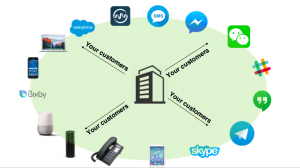 As consumers expect instant satisfaction with their customer experiences – and a readiness to voice their displeasure over social media – they increase the pressure on businesses to effectively and correctly answer customer queries. With that in mind, C-suite executives across industries are increasingly focused on creating a customer experience that is responsive, intelligent and accurate. When any company grievance can be shared instantly and publicly, executives know that it’s critical to connect with their customers instantly and efficiently wherever they are.
As consumers expect instant satisfaction with their customer experiences – and a readiness to voice their displeasure over social media – they increase the pressure on businesses to effectively and correctly answer customer queries. With that in mind, C-suite executives across industries are increasingly focused on creating a customer experience that is responsive, intelligent and accurate. When any company grievance can be shared instantly and publicly, executives know that it’s critical to connect with their customers instantly and efficiently wherever they are.
Many are turning toward Artificial Intelligence (AI)-powered chatbots to answer queries quickly and correctly, while increasing customer satisfaction. In fact, an Oracle survey found that 80 percent of businesses want to deploy a chatbot by 2020, while a Digital Pulse survey found that 85 percent of consumers prefer to interact with a bot. Sounds like a done deal: all enterprises and customer-focused organizations should implement conversational AI bots to make their customer metrics soar.
AI Chatbots Have Yet To Prove They’re Up For The Task
But AI chatbots have yet to prove they’re up for the task. An October 2017 survey conducted by EdgePeak Consulting found that customer service professionals are concerned that chatbots won’t understand what their customers are saying. Nearly 50 percent believe a chatbot will improperly or incorrectly handle a customer’s request and nearly 40 percent believe there would be errors in a chatbot’s comprehension of a customer’s request. There were other concerns as well. More than 40 percent believed they would have difficulty integrating a conversational interface within their existing, legacy systems.
Also Read: Are Your Consumers Getting Along With Chatbots?
However, the concerns are unfounded. AI chatbots have been found to respond to customer requests and questions more efficiently and accurately than a human employee, freeing up the employee to focus on valued work and customer issues that can’t be resolved by a chatbot. In fact, conversational AI chatbots can respond with up to 99 percent accuracy and have much higher response rates than human staff. There’s no reason corporations and customer support organizations should not implement conversational AI, as there are simple solutions available that can be deployed in as soon as two weeks and without hiring extra staff.
The requirements for implementing AI-driven conversational interfaces that drive superior customer experience, while also addressing the concerns of customer service professionals, have the following characteristics:
- A bot builder, which is easy to use for building a bot, without the need to write a single line of code.
- A bot trainer, which has the kind of depth enabling it to better understand a user, no matter how they express themselves, and uses one of the most sophisticated deep-learning models – long short-term memory. This brings the same sort of AI “horsepower” to an NLP interface associated with self-driving cars and package-delivering drones.
- A bot deployment that can deploy the bot anywhere a customer wants to reach the company.
Don’t Hire A Bot-building Team
An automated conversational interface solution must work seamlessly within legacy enterprise systems, across any type of messaging or voice-based platform. A company should not need to hire a bot-building team, and employees should not require computer programming experience. The system should be able to be built and deployed, easily and quickly, across the enterprise (some can be deployed in as few as three weeks), providing feedback and the ability to fine-tune processes and responses as needed.
Once built, the bot should be trained and educated so it’s intelligent enough to understand and respond to normal speech patterns. This includes understanding natural language, intents, extracting information, triggering actions, understanding questions and sentiment, processing speech and more. For an AI-powered chatbot to have success within an organization, it must be able to handle these conversational AI building blocks.
Also Read: 28 Ways Artificial Intelligence Will Affect Your Business and Life in 2018
Chatbots Drive Improvement In Customer Satisfaction Scores
Many companies have seen customer satisfaction scores improve as they implement AI-powered chatbots. For example, a customer may call in with a common issue, such as when a customer loses Internet connectivity and the solution is to simply switch off the router and power it back on. Instead of a long wait on hold to receive instructions to reboot a computer or switching the router off and of, a customer can sidestep any potential frustration with a bot providing immediate, easy-to-understand instructions. All this frees up agents for more complex issues. Ensuring that the users’ needs are met, it should also seamlessly pass incoming customer calls to a human when necessary.
The AI chatbot will only improve, using the latest in machine learning and deep learning algorithms to constantly learn, evolve, and understand multiple languages, while also providing a rich set of analytics to help understand, train and improve the overall system.
Finally, the bot deployment should happen wherever a company wants to talk to customers, whether on a website, Facebook channel, Amazon Alexa, Google Home and even SMS. Many companies are also implementing bots to handle internal employee questions via Slack.
 The survey did find that customer service executives perceived many benefits in deploying a conversational AI chatbot, including increased customer satisfaction and higher-quality customer experiences, as well as the ability to offer instant gratification to users by providing immediate responses.
The survey did find that customer service executives perceived many benefits in deploying a conversational AI chatbot, including increased customer satisfaction and higher-quality customer experiences, as well as the ability to offer instant gratification to users by providing immediate responses.
As consumers continue to embrace bots and business leaders become more educated about their benefits, it’s clear that AI-powered chatbots have the power to significantly improve customer support, all while continuing to learn how to deliver better and better customer experiences.












Comments are closed.